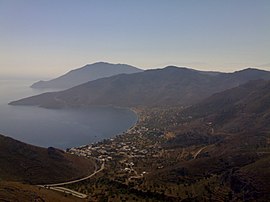Tilos
|
Tilos Τήλος |
|
|---|---|

View over Livadia, the port and main village on Tilos
|
|
| Coordinates: 36°26′N 27°22′E / 36.433°N 27.367°ECoordinates: 36°26′N 27°22′E / 36.433°N 27.367°E | |
| Country | Greece |
| Administrative region | South Aegean |
| Regional unit | Rhodes |
| Area | |
| • Municipality | 64.525 km2 (24.913 sq mi) |
| Highest elevation | 654 m (2,146 ft) |
| Lowest elevation | 0 m (0 ft) |
| Population (2011) | |
| • Municipality | 780 |
| • Municipality density | 12/km2 (31/sq mi) |
| Time zone | EET (UTC+2) |
| • Summer (DST) | EEST (UTC+3) |
| Postal code | 850 02 |
| Area code(s) | 22460 |
| Vehicle registration | ΚΧ, ΡΟ, ΡΚ |
| Website | www.tilos.gr |
Tílos (Greek: Τήλος; ancient form: Telos) is a small Greek island and municipality located in the Aegean Sea. It is part of the Dodecanese group of islands, and lies midway between Kos and Rhodes. It has a population of 780 inhabitants (2011 census). Along with the uninhabited offshore islets of Antitilos and Gaidaros, it forms the Municipality of Tilos, which has a total land area of 64.525 square kilometres (24.913 sq mi). Tilos is part of the Rhodes regional unit.
Popularly, Telos was the son of Helios and Halia, the sister of the Telchines. He came to the island in search of herbs to heal his ill mother, and later returned to found a temple to Apollo and Neptune. However, Telos (Telo or Tilo) does not appear in Greek mythology and the name probably has an unknown pre-Hellenic origin. Pliny the Elder notes that in antiquity Telos was known as Agathussa (Αγαθούσσα) (also Agathusa and Agathousa). In the Middle Ages, it was known by the Italian as Episcopio, either because it was a Bishop Seat or because its position as Vantage Point. The island has also been called in Turkish İlyaki and in modern Italian Piscopi.
Pottery and stone tools discovered in Charkadio cave indicate human activity on Tilos in the early Neolithic period (8000 BC to 7000 BC), along with the large assembly of bones of 1.2-to-1.6-metre-tall (3-foot-11-inch-to-5-foot-3-inch) dwarf elephants, carbon dated to between 4000 and 7000 BC (some now in the museum). Masseti (2001) suggests coexistence of these animals with humans, possibly into the historic period.
...
Wikipedia


